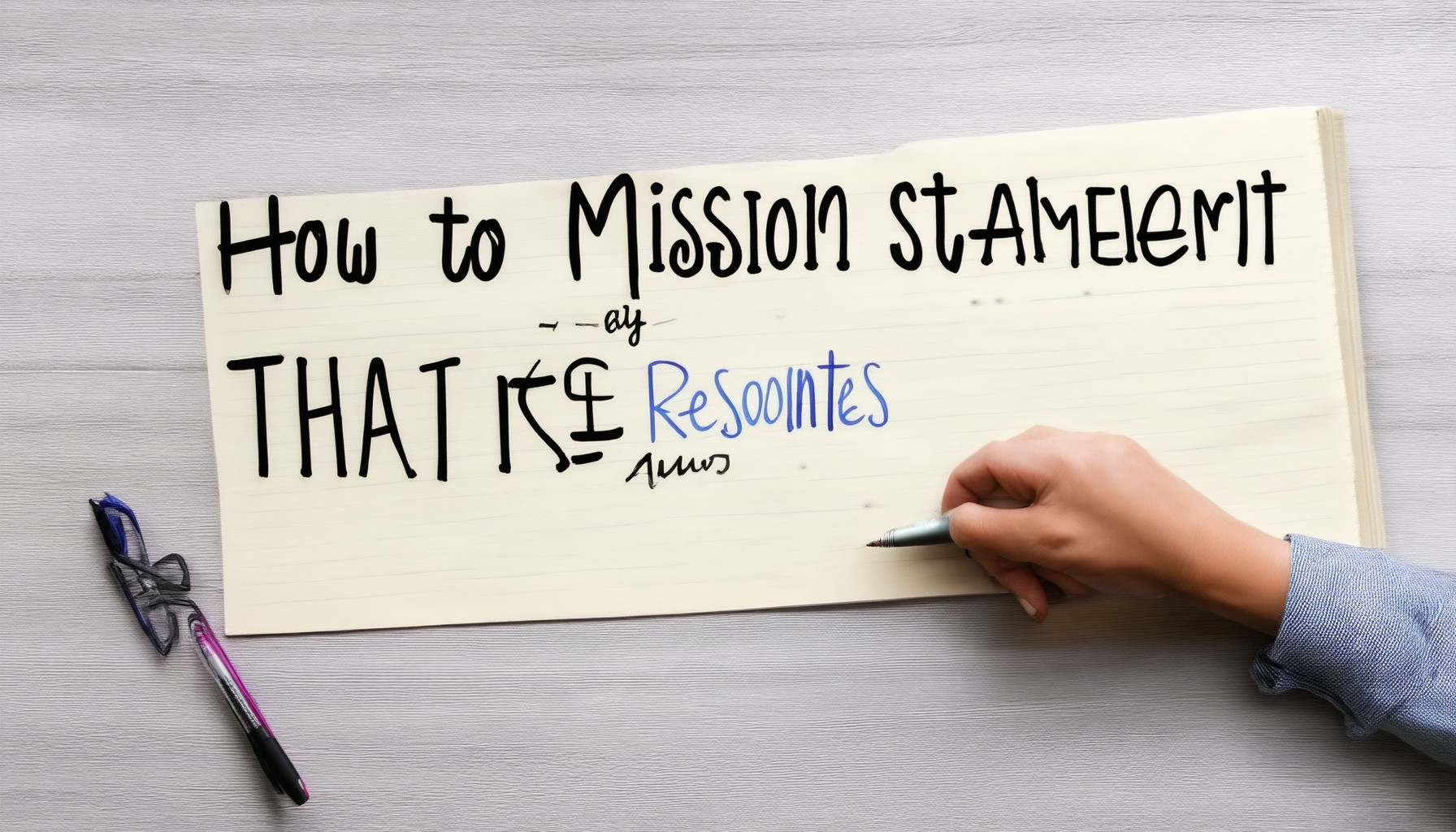Creating a mission statement that resonates with your audience and clearly defines your organization’s purpose is a critical task for businesses, nonprofits, and even individuals. Whether you’re crafting a mission statement for a bustling company, a dedicated charity, or your personal journey, the ability to articulate your core values and goals effectively is paramount. However, crafting a mission statement that not only clearly defines your purpose but also inspires action can be challenging. Many organizations struggle with balancing brevity with depth, ensuring their message resonates with stakeholders while standing out among competitors. In this guide, we’ll explore the essential steps to craft a mission statement that is both impactful and memorable, helping you align your organization’s vision with its actions and inspire those around you to join your cause. From understanding your core values to setting measurable goals, we’ll walk you through the process of creating a mission statement that truly resonates with your audience and drives meaningful change.
Key Takeaways
– Clarity and Simplicity: Craft a mission statement that immediately communicates your purpose with jargon-free language.
– Purpose, Approach, and Impact: Structure your mission to include what you solve, how you solve it, and the outcomes you aim for.
– Audience-Centric Language: Use emotional and relatable terms to connect with your target audience.
– Inspiration and Call to Action: End with language that motivates others to get involved.
– Alignment with Values: Reflect your organization’s core beliefs to build a cohesive and authentic narrative.
– SEO Considerations: Incorporate keywords to enhance discoverability and relevance.
– Be Memorable and Specific: Avoid generics; specify how you help and what makes your approach unique.
– Tailor to Your Audience: Adjust your language to resonate with their values and needs.
– Measurable Goals: Include specific, actionable targets to drive accountability.
– Avoid Jargon: Keep your mission understandable to all audiences.
– Revise and Refine: Polish your statement and seek feedback for maximum impact.
By focusing on these elements, you can create a mission statement that clearly defines your purpose, engages your audience, and drives meaningful action.

How to Craft a Mission Statement That Resonates and Inspires Action
A well-crafted mission statement is a cornerstone of organizational communication, serving as a beacon of purpose and guiding principles. To create one that resonates with your audience and inspires action, consider the following steps:
- Clarity and Simplicity : Begin with a clear, concise statement that immediately communicates your organization’s purpose. Avoid jargon and ensure your message is easily understandable.
- Purpose, Approach, and Impact : Structure your mission statement to include three key elements:
- Purpose : What problem are you solving or what goal are you aiming to achieve?
- Approach : Describe the methods or strategies you use to reach your goals.
- Impact : Highlight the difference your efforts make and the outcomes you aim to achieve.
- Audience-Centric Language : Use language that connects emotionally with your target audience. Consider terms that evoke empathy, motivation, and a sense of belonging.
- Inspiration and Call to Action : End your mission statement with language that motivates people to take action, whether it’s volunteering, donating, or supporting your cause.
- Alignment with Values : Ensure your mission reflects your organization’s core values and beliefs, providing a cohesive narrative that resonates internally and externally.
- SEO Considerations : Incorporate keywords that potential stakeholders might search for, ensuring your mission statement is discoverable and relevant.
Example Mission Statement : “Empowering Tomorrow’s Leaders: Innovative Educational Tools for Student Success”
This mission statement clearly defines the purpose (empowering leaders), the approach (innovative educational tools), and the impact (student success). It is concise, emotionally resonant, and inspiring, making it an effective tool for driving action and building brand identity.
By thoughtfully crafting your mission statement, you can clearly articulate your organization’s purpose while engaging your audience and motivating them to contribute to your shared goals.
How to Craft a Mission Statement That Resonates and Inspires Action
To craft a mission statement that clearly outlines an organization’s purpose while connecting with its audience and motivating them to take action, follow these organized steps:
- Identify Core Values : Begin by uncovering the organization’s core values, which should guide the mission statement. Use tools like the Balanced Scorecard to systematically assess and define these values, ensuring they reflect the organization’s culture and past actions.
- Define the Problem : Clearly articulate the issue the organization addresses. Conduct research or surveys to understand the audience’s challenges and present the problem in a way that highlights its importance and impact.
- Present the Solution : Highlight how the organization tackles the identified problem through its offerings. Use examples or case studies to demonstrate the effectiveness of these solutions, ensuring they are relatable and actionable.
- Inspire Action : Use strong verbs and create a sense of urgency. Incorporate success stories or testimonials to make the impact tangible. Provide clear options for involvement, such as volunteering or donating, to facilitate easy action.
- Align with Audience Values : Research the audience’s motivations and beliefs to tailor the mission statement. Use tools like social media analytics to identify shared values and reflect them in the statement for greater appeal.
- Include a Long-Term Vision : Set ambitious goals to ensure sustainable change. This provides a roadmap and offers hope, aligning the mission with future aspirations.
- Structure and Clarity : Keep the mission concise and memorable, using bullet points or key phrases if needed. Balance detail with brevity to maintain clarity without overwhelming the reader.
- Avoid Jargon : Use simple, accessible language while maintaining professionalism. Consider developing a style guide to standardize language use and ensure understanding across all audiences.
- Refine and Revise : Seek feedback from diverse stakeholders, including board members, employees, and donors, to enhance clarity and relevance. This input helps in refining the mission to better meet organizational goals.
- Integrate with Branding : Ensure the mission complements the organization’s visual identity and messaging. Consistency in tone and style is crucial for effective communication across all platforms.
- Adaptability : Regularly review and update the mission statement to remain relevant in a changing world. Annual assessments and stakeholder meetings can help evaluate effectiveness and adjust the mission as needed.
- Competitor Analysis : Analyze competitors’ mission statements for inspiration while ensuring your organization’s unique values and goals are preserved. Draw on their successes without copying.
By following these steps, the mission statement will not only clearly outline the organization’s purpose but also effectively engage and motivate the audience to take action.

How to Craft a Mission Statement That Resonates and Inspires Action
A well-crafted mission statement is a cornerstone of organizational communication, serving as a beacon of purpose and guiding principles. To create one that resonates with your audience and inspires action, consider the following steps:
- Clarity and Simplicity : Begin with a clear, concise statement that immediately communicates your organization’s purpose. Avoid jargon and ensure your message is easily understandable.
- Purpose, Approach, and Impact : Structure your mission statement to include three key elements:
- Purpose : What problem are you solving or what goal are you aiming to achieve?
- Approach : Describe the methods or strategies you use to reach your goals.
- Impact : Highlight the difference your efforts make and the outcomes you aim to achieve.
- Audience-Centric Language : Use language that connects emotionally with your target audience. Consider terms that evoke empathy, motivation, and a sense of belonging.
- Inspiration and Call to Action : End your mission statement with language that motivates people to take action, whether it’s volunteering, donating, or supporting your cause.
- Alignment with Values : Ensure your mission reflects your organization’s core values and beliefs, providing a cohesive narrative that resonates internally and externally.
- SEO Considerations : Incorporate keywords that potential stakeholders might search for, ensuring your mission statement is discoverable and relevant.
Example Mission Statement : “Empowering Tomorrow’s Leaders: Innovative Educational Tools for Student Success”
This mission statement clearly defines the purpose (empowering leaders), the approach (innovative educational tools), and the impact (student success). It is concise, emotionally resonant, and inspiring, making it an effective tool for driving action and building brand identity.
By thoughtfully crafting your mission statement, you can clearly articulate your organization’s purpose while engaging your audience and motivating them to contribute to your shared goals.

How to Craft a Mission Statement That Resonates and Inspires Action
A well-crafted mission statement is a cornerstone of organizational communication, serving as a beacon of purpose and guiding principles. To create one that resonates with your audience and inspires action, consider the following steps:
- Clarity and Simplicity : Begin with a clear, concise statement that immediately communicates your organization’s purpose. Avoid jargon and ensure your message is easily understandable.
- Purpose, Approach, and Impact : Structure your mission statement to include three key elements:
- Purpose : What problem are you solving or what goal are you aiming to achieve?
- Approach : Describe the methods or strategies you use to reach your goals.
- Impact : Highlight the difference your efforts make and the outcomes you aim to achieve.
- Audience-Centric Language : Use language that connects emotionally with your target audience. Consider terms that evoke empathy, motivation, and a sense of belonging.
- Inspiration and Call to Action : End your mission statement with language that motivates people to take action, whether it’s volunteering, donating, or supporting your cause.
- Alignment with Values : Ensure your mission reflects your organization’s core values and beliefs, providing a cohesive narrative that resonates internally and externally.
- SEO Considerations : Incorporate keywords that potential stakeholders might search for, ensuring your mission statement is discoverable and relevant.
Example Mission Statement : “Empowering Tomorrow’s Leaders: Innovative Educational Tools for Student Success”
This mission statement clearly defines the purpose (empowering leaders), the approach (innovative educational tools), and the impact (student success). It is concise, emotionally resonant, and inspiring, making it an effective tool for driving action and building brand identity.
By thoughtfully crafting your mission statement, you can clearly articulate your organization’s purpose while engaging your audience and motivating them to contribute to your shared goals.
Crafting an Effective Mission Statement: A Step-by-Step Guide
To craft a mission statement that resonates with your audience and reflects your values, follow these organized steps:
- Define the Purpose : Clearly state what your organization does and its reason for existence. For example, “To empower underserved communities through educational programs and resources.” Incorporate this into your mission statement to establish a solid foundation.
- Describe the Approach : Explain the methods or strategies used to achieve your mission. For instance, “We will implement after-school tutoring programs and mentorship initiatives to support student success.” This adds specificity to your mission.
- Mention the Impact : Highlight the outcomes or effects of your efforts. Example: “Our goal is to increase high school graduation rates by 20% over the next five years.” This creates a measurable objective.
- Align with Values : Integrate core values such as integrity, compassion, or innovation. Example: “In doing so, we uphold our commitment to equity and community-driven solutions.” This connects your mission to your organizational principles.
- Be Unique and Specific : Avoid generic statements. Instead of “We help people,” specify how you help them. Example: “We connect volunteers with local schools to provide literacy programs for children.” This makes your mission memorable.
- Consider Audience Resonance : Tailor the language to appeal to your target audience. Tech-focused nonprofits might emphasize innovation, while community centers could focus on building connections and fostering belonging.
- Include Measurable Goals : Add specific, actionable targets. Example: “We aim to serve 500 meals each month to low-income families.” This provides direction and accountability.
- Avoid Jargon : Keep the language simple and accessible to all audiences. Your mission statement should be understandable to everyone, regardless of their familiarity with your cause.
- Revise and Refine : Read your draft aloud to check for clarity and flow. Seek feedback from trusted colleagues or advisors to enhance effectiveness. This step ensures your mission statement is polished and impactful.
By following these steps, you can create a mission statement that is clear, inspiring, and aligned with your organization’s goals and values. For further insights and tools to enhance your nonprofit’s mission statement, explore NPO Expert’s comprehensive resources .

How to Craft a Mission Statement That Resonates with Your Audience
A mission statement serves as the heart of an organization, clearly defining its purpose and guiding its actions. To craft one that resonates with your audience, follow these steps:
1. Identify Your Core Purpose
Start by pinpointing the fundamental reason your organization exists. Consider the problem it solves and how it uniquely addresses it compared to competitors. This clarity forms the foundation of your mission statement.
2. Align with Your Audience’s Values
Tailor your mission statement to reflect the values of your target audience. For instance, if your audience prioritizes sustainability, emphasize eco-friendly initiatives in your statement.
3. Keep It Clear and Concise
A mission statement should be brief and straightforward to capture attention quickly. Avoid jargon and ensure it communicates your purpose clearly without ambiguity.
4. Highlight Unique Selling Points
Integrate what makes your organization stand out. Whether it’s innovative approaches or a proven track record, showcasing these traits adds credibility and appeal.
5. Connect to Broader Objectives
Ensure your mission aligns with your organization’s vision and long-term goals. This linkage demonstrates strategic direction and inspires confidence in your roadmap.
6. Match Your Organizational Culture
Your mission statement’s tone should reflect your company’s culture. Authenticity and relatability are key to resonating with your audience and fostering trust.
7. Stay Flexible and Evolve
Regularly review and update your mission statement as your organization grows. Adaptability ensures it remains relevant in changing circumstances.
8. Gather Feedback and Refine
Engage stakeholders, including employees and customers, to gather insights. This feedback loop helps refine your mission statement for maximum impact.
For further insights, explore resources from NPO Expert , which offers comprehensive guides on nonprofit management and fundraising strategies. Their expertise can enhance your mission statement’s effectiveness.
By following these steps, you can craft a mission statement that not only defines your organization’s purpose but also deeply resonates with your audience, driving meaningful change and inspiration.





0 Comments